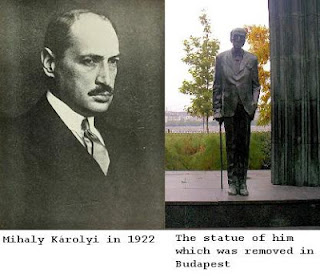Editor's Note: The descendants of Károly wanted the statue to be moved from Kossuth Square. The artist who created the statue wanted the statue to be moved to Siófok, Hungary. The only people who opposed moving the statue were socialists and the far left-wing.
Hungarian patriots and nationalists are rejoicing. Yesterday, the statue of Mihaly Károlyi was removed. The statue had stood in Kossuth Square by the Hungarian Parliament Building. It should be noted that the statue was erected in 1975 as a tribute to Mihaly Károlyi. The conservative coalition government of Orbán Viktor decided to remove the statue. The government wanted Kossuth Square to look the way it originally looked before the Second World War. Károlyi was Hungarian prime minister from November 1st to the 16th, 1918. He also served as the president from November 16th, 1918, to March 21st, 1919.
To many in Hungary today, he is viewed as a negative figure. It was his actions after the First World War that lead Hungary to be severely weakened and to lose large amounts of territory. The armistices imposed on Hungary after World War One were very harsh and severe. Hungary was an unwilling partner in the Austro-Hungarian Empire and did not want war in 1914. Károlyi had proclaimed himself as a follower of Woodrow Wilson's Fourteen Points. Woodrow Wilson was America's president during the First World War. He is often identified as one of the first globalists as it was Wilson who started the League of Nations which was the forerunner to the United Nations today. Károlyi also abolished most of the Hungarian armed forces in November 1918. It was the Romanians, Slovaks and Yugoslavs who often broke the armistice to seize more territory for themselves.
Károlyi had become more progressive and left-wing in his political career. Just like communism in Russia, when he was in power he wanted to redistribute all the rural lands held by aristocrats and capitalists to the peasants. A ruling coalition party, the Social Democrats, blocked this goal. It was the consequences of Karolyi's weak actions that gave rise to Kun Béla and the Hungarian Soviet Republic. It is a known fact that Karolyi's wife Katinka, was a personal friend of Kun Béla and his entourage. Kun Béla's communists took power in Hungary in 1919, at which point Károlyi retired from political life.
During the Second World War, Károlyi would spend time in exile in Britain. He would eventually return to Hungary and become the Hungarian ambassador to France from 1947 to 1949. By this time, he would officially become a socialist. Károlyi died in Vence, France in 1955. His short rule has become very controversial and a majority of Hungarians see him in a negative light. He is identified as a weak political figure that lead to Hungary's demise immediately after the First World War. This gave rise to Kun Béla and the communists in 1919. Even though the Hungarian Soviet republic did not last long, the damage inflicted by the communists was incredible. It is no surprise that many Hungarians today are not sad to see the statue go. It is a little ironic that the communists in Hungary waited until 1975, to erect a statue in his honour. Károlyi had an aristocratic background. The statue will be moved to the train station in Siófok, near Lake Balaton.
Istvan

